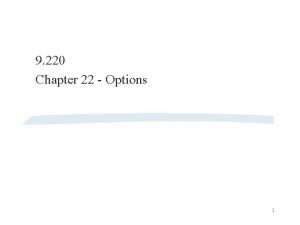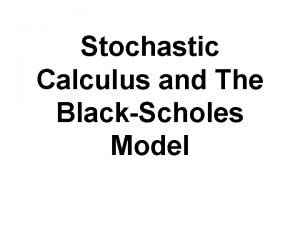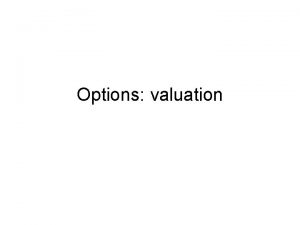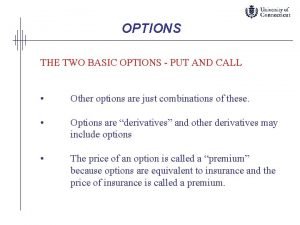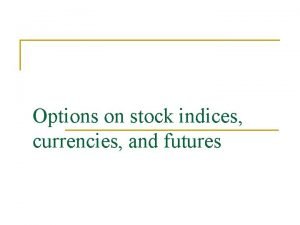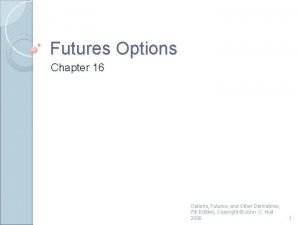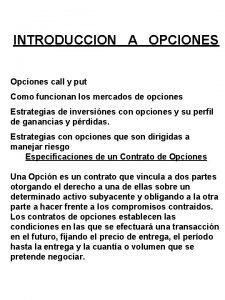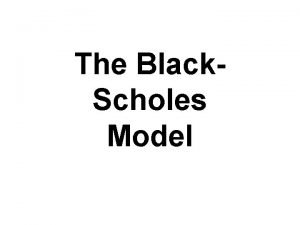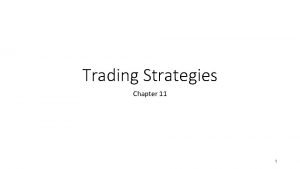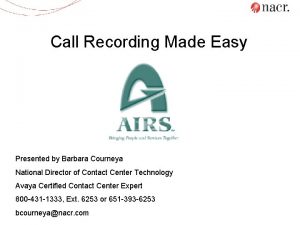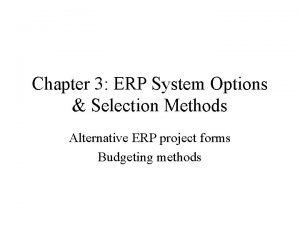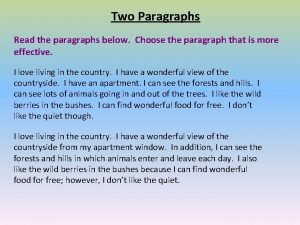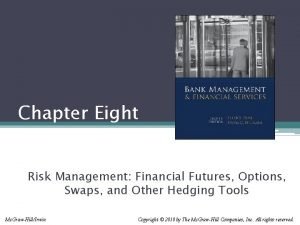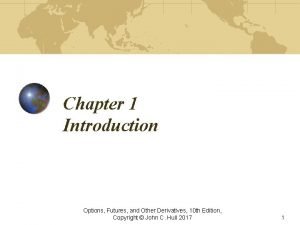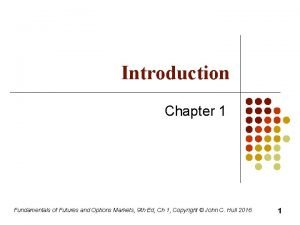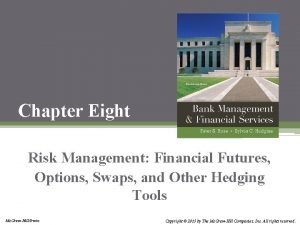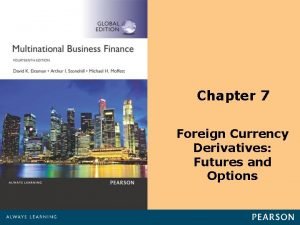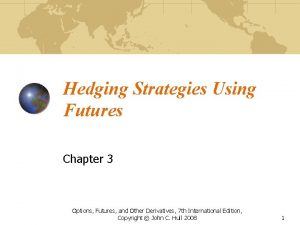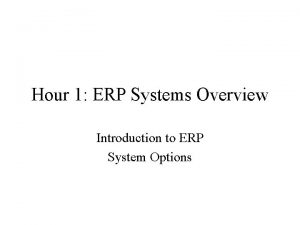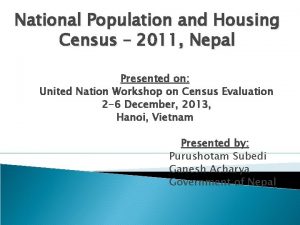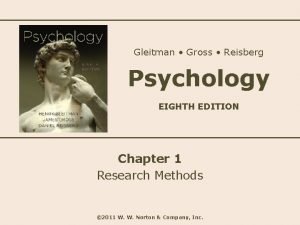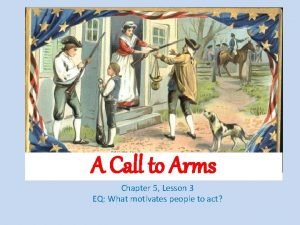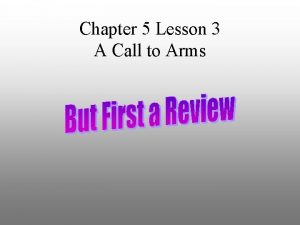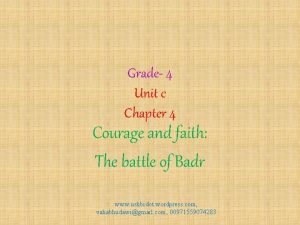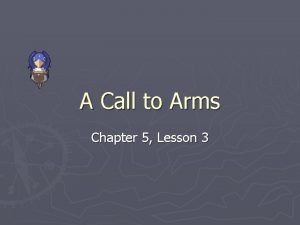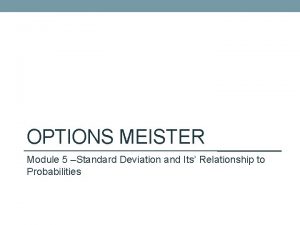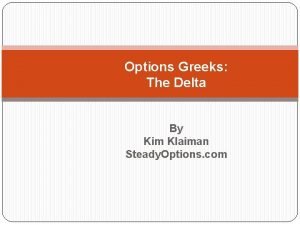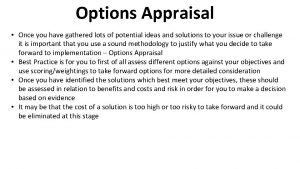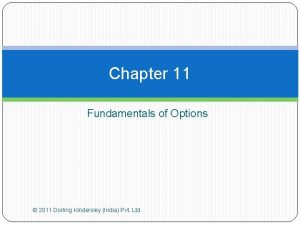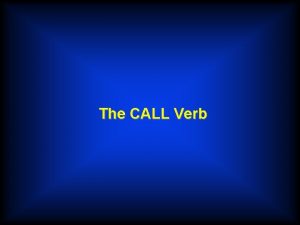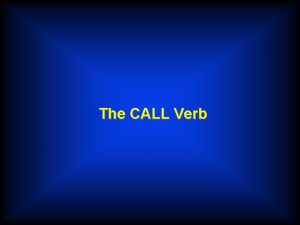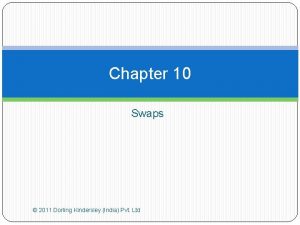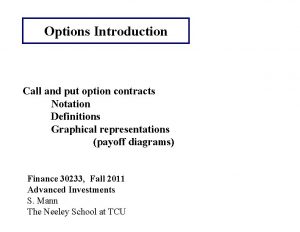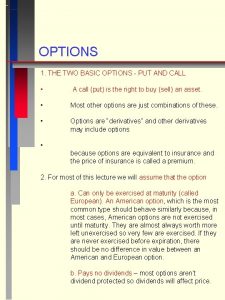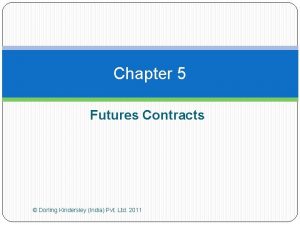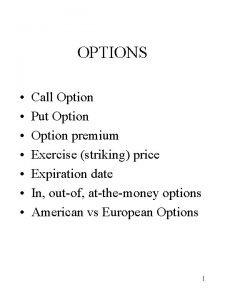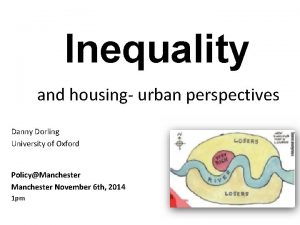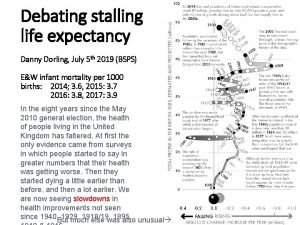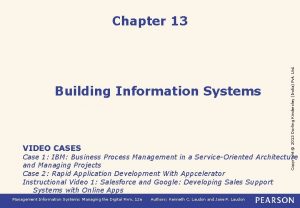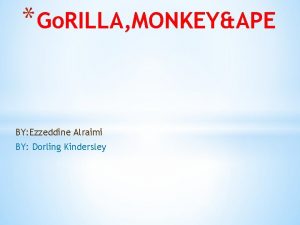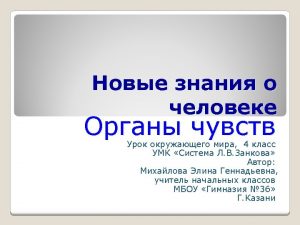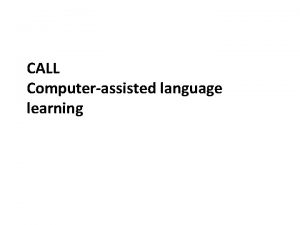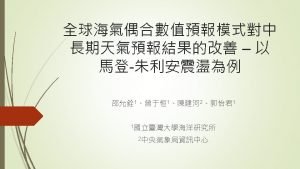Chapter 7 Call and Put Options 2011 Dorling








































- Slides: 40

Chapter 7 Call and Put Options © 2011 Dorling Kindersley (India) Pvt. Ltd

Objectives What are call and put options? How are values created for options? When would American options be exercised before maturity? When would traders write or buy options? © 2011 Dorling Kindersley (India) Pvt. Ltd

What are Call Options? A call option is a contract between a writer and buyer, in which the call buyer gets the right to buy a specified quantity of asset at exercise price on the exercise date (in the case of a European call) or at any time before the exercise date (in the case of an American call) Call options are available on individual stocks, stock indices, interest rates, exchange rates, commodities and futures contracts In India, call options on individual stocks and stock indices are available in OTC Commodity options and options on futures are not yet available in India © 2011 Dorling Kindersley (India) Pvt. Ltd

Exercise of European Call Options Since European call options provide call buyers with the right to buy an underlying asset at the exercise price or exercise date, the call buyer will exercise only if the spot price on the exercise date (ST) is larger than the exercise price (SX) If ST > SX, value to the call buyer will be the difference between the stock price on the exercise date and the exercise price (ST – SX) If ST < SX, the call buyer will make a loss if the call is exercised; therefore, they will not exercise the call option, but let it expire © 2011 Dorling Kindersley (India) Pvt. Ltd

Terminal Value of a Bought Call The value of a bought call option on the exercise date is known as the terminal value of the bought call Since the call will only be exercised if ST > SX, the value of the call if exercised will be ST – SX If the call is not exercised, i. e. If ST < SX, the call will expire without exercise and its value will be zero Terminal value of a bought call = max {(ST – SX), 0} © 2011 Dorling Kindersley (India) Pvt. Ltd

Terminal Value of a Bought Call © 2011 Dorling Kindersley (India) Pvt. Ltd

Gains and Losses from a Bought Call The premium paid for a call is C 0 The terminal value is Max {(ST – SX), 0} The gain or loss is {(ST – SX – C 0), – C 0} The maximum loss is C 0, which is the premium paid The maximum gain depends on how high stock prices go © 2011 Dorling Kindersley (India) Pvt. Ltd

Gains and Losses from Bought Call © 2011 Dorling Kindersley (India) Pvt. Ltd

Value of a Call Before Maturity Before maturity, a call could be in-the-money, at-the- money or out-of-money The intrinsic value of a call is Max {(ST – SX), 0} Time value of a call is the value because the option could turn into money by maturity The value of a call before maturity is the intrinsic value + the time value Time value is positive and based on probability that the call will be in-the-money at maturity © 2011 Dorling Kindersley (India) Pvt. Ltd

Value of a Call Before Maturity © 2011 Dorling Kindersley (India) Pvt. Ltd

Minimum and Maximum Values of a Call Minimum value or lower bound = Max {(ST – SX), 0} Maximum value or upper bound = stock price as call cannot sell above stock price © 2011 Dorling Kindersley (India) Pvt. Ltd

Lower and Upper Bounds for Call © 2011 Dorling Kindersley (India) Pvt. Ltd

When to Exercise an American Call American calls on stock that pay no dividends will not be exercised easily If exercised, the payoff is intrinsic value, whereas if an option is sold, the value is intrinsic value + time value American calls on stocks that pay dividends can be exercised early Dividends would reduce the stock price and the time value would become smaller, even be negative Exercise the call on ex-dividend date when the time value is negative © 2011 Dorling Kindersley (India) Pvt. Ltd

Terminal Value of a Written Call For a writer of a call, there is an obligation only when the call is exercised Since calls are exercised only when ST –SX, the loss for the writer would be SX – ST If the call is not exercised, the call will have no value The terminal value of a written call is Min {(SX – ST), 0} © 2011 Dorling Kindersley (India) Pvt. Ltd

Terminal Value of a Written Call © 2011 Dorling Kindersley (India) Pvt. Ltd

Gains and Losses for a Call Writer When a writer writes a call, they will receive call premium C 0 If the call is exercised, the loss is reduced by C 0 If the call is not exercised, the writer will keep C 0 Gain and loss for the call writer = min {C 0, C 0 + (ST – SX)} Maximum gain is C 0 and maximum loss depends on how high stock prices go © 2011 Dorling Kindersley (India) Pvt. Ltd

Gains and Losses for a Call Writer © 2011 Dorling Kindersley (India) Pvt. Ltd

Comparison of Payoff to a Call Buyer and a Call Writer For a call buyer, the maximum loss is the call premium, and gains can be high For a call writer, the maximum gain is the call premium, and losses can be high Zero-sum game, as gains for a buyer are the same as losses for the writer, and vice-versa Diagram shows payoff for writer in a mirror-image of the payoff for a buyer © 2011 Dorling Kindersley (India) Pvt. Ltd

Comparison of Payoff to a Call Buyer and a Call Writer © 2011 Dorling Kindersley (India) Pvt. Ltd

When to Buy and When to Write Calls A call is basically a between the buyer and the writer The buyer bets that the stock price will be higher than the sum of the exercise price and the call premium The writer bets that the stock price will not exceed the sum of the exercise price and call premium One will buy a call if it is expected that ST > SX + C 0 They will write a call if it is expected that ST < SX + C 0 © 2011 Dorling Kindersley (India) Pvt. Ltd

What Are Put Options? A put option is a contract between a writer and a buyer, in which the put buyer gets the right to sell a specific quantity of underlying asset at the exercise price on the exercise date (if a European put), or at any time before the exercise date (if an American put) Put options are available on individual stocks, stock indices, interest rates, exchange rates, commodities, and futures contracts In India, puts on individual stocks and stock indices are traded in exchanges Puts on interest rate and exchange rate are available OTC Commodity puts and puts on futures are not yet available in India © 2011 Dorling Kindersley (India) Pvt. Ltd

Exercise of European Put Options Since European put options provide the right to a put buyer to sell the underlying asset at the exercise price on the exercise date, the put buyer will exercise only if the spot price on the exercise date (ST) is lower than the exercise price (SX) If ST < SX, the value to the put buyer will be the difference between the exercise price and the stock price on the exercise date (SX – ST) If ST > SX, the put buyer will make a loss if the put is exercised, and will therefore not exercise the put, instead letting it expire © 2011 Dorling Kindersley (India) Pvt. Ltd

Terminal Value of a Bought Put The value of a bought put option on the exercise date is known as the terminal value of the bought put Since the put will only be exercised if SX > ST, the value of the bought put if exercised will be SX – ST IF the put is not exercised, i. e. If SX < ST, the put will expire without exercise and its value will be zero The terminal value of a bought put = max {(SX – ST), 0} © 2011 Dorling Kindersley (India) Pvt. Ltd

Terminal Value of a Bought Put © 2011 Dorling Kindersley (India) Pvt. Ltd

Gains and Losses from a Bought Put Premium paid for a put is P 0 Terminal value = max {(SX – ST), 0} Gain or loss = max {(SX – ST – P 0), – P 0} Maximum loss is P 0, which is premium paid Maximum gain is SX, as ST can reach a minimum of zero © 2011 Dorling Kindersley (India) Pvt. Ltd

Gains and Losses from a Bought Put © 2011 Dorling Kindersley (India) Pvt. Ltd

Value of a Put Before Maturity Before maturity, a put can be in-the-money, at-the-money, or out-of-money Intrinsic value of put = Max {(SX – ST), 0} Time value of a put is the value because the put could turn into money by maturity The value of a put before maturity = intrinsic value + time value Time value is positive, and based on the probability that the put will be in-the-money at maturity © 2011 Dorling Kindersley (India) Pvt. Ltd

Value of a Put Before Maturity © 2011 Dorling Kindersley (India) Pvt. Ltd

Minimum and Maximum Values of a Put Minimum value or lower bound = Max {(SX – ST), 0} Maximum value or upper bound = SX © 2011 Dorling Kindersley (India) Pvt. Ltd

Lower and Upper Bounds For Put © 2011 Dorling Kindersley (India) Pvt. Ltd

When to Exercise an American Put For non-dividend-paying stock, in general, an American put that pays no dividend will not be exercised early, because the value of the put is higher than the intrinsic value that will be received on exercise If stock price is very low relative to the exercise price, the probability of the price going lower may be very small and the time value might be negative. Therefore, the early exercise price may be appropriate For dividend paying stock, a large dividend may reduce the stock price, causing the time value to be negative; if that happens, the option can be exercised early © 2011 Dorling Kindersley (India) Pvt. Ltd

Terminal Value of a Written Put For writers of put, there is an obligation only when the put is exercised Since put is exercised only when SX > ST, the loss for writer would be ST – SX If the put is not exercised, it has no value Terminal value of a written put = Min (ST – SX), 0} © 2011 Dorling Kindersley (India) Pvt. Ltd

Terminal Value of a Written Put © 2011 Dorling Kindersley (India) Pvt. Ltd

Gains and Losses for a Put Writer When a put writer writes a put, he receives P 0 If the put is exercised, the loss is reduced by P 0 If the put is not exercised, the writer will keep P 0 Gains and losses for the put writer = Min {P 0, [(SX – ST) + P 0]} Maximum gain is P 0, and maximum loss is (SX – P 0) © 2011 Dorling Kindersley (India) Pvt. Ltd

Gains and Losses for Put Writer © 2011 Dorling Kindersley (India) Pvt. Ltd

Comparison of Payoffs to Put Buyers and Put Writers For a put buyer, the maximum loss is the put premium, and gain can be high with a maximum of (SX – P 0) For put writers, the maximum gain is the put premium, and loss can be high with a maximum of (SX – P 0) It is a zero-sum game, as gains for buyers are the same as losses for writers, and vice-versa Diagram shows that payoffs for a writer mirror-image payoffs for buyers © 2011 Dorling Kindersley (India) Pvt. Ltd

Comparison of Payoff to Put Buyer and Writer © 2011 Dorling Kindersley (India) Pvt. Ltd

When to Buy Put and Write Put is a between a writer and a buyer The buyer bets that the stock price will be lower than (SX – P 0) The writer bets that the stock price will not be lower than (SX – P 0) One should buy put if it is expected that ST < SX - P 0 They will write a put if it is expected that ST > SX + P 0 © 2011 Dorling Kindersley (India) Pvt. Ltd

Comparison between Calls and Puts One should buy call when the stock price is expected to increase and go beyond (SX + C 0) They should buy put when the stock price is expected to decrease and go below (SX – P 0) Writing a call does not necessarily mean that stock prices should decrease Writing a put does not necessarily mean that stock prices should increase © 2011 Dorling Kindersley (India) Pvt. Ltd

When to Buy or Write Calls and Puts Buy put if ST < (SX – C 0 – P 0) Write call if (SX – C 0 – P 0) < ST < (SX + C 0 – P 0) Write put if (SX + C 0 – P 0) < ST < (SX + C 0 + P 0) Buy call if ST < (SX + C 0 + P 0) © 2011 Dorling Kindersley (India) Pvt. Ltd
 Put options
Put options Put out the light othello
Put out the light othello You put your left foot in
You put your left foot in Put call formula
Put call formula Put call parity
Put call parity Put call parity formula
Put call parity formula Put call parity formula
Put call parity formula Futures style options
Futures style options Putcall parity
Putcall parity Opciones call y put
Opciones call y put Put call parity
Put call parity Box spread
Box spread What is options
What is options Qfiniti call recording
Qfiniti call recording Chapter 3 foodservice career options
Chapter 3 foodservice career options Systems analysis & design in an age of options pdf
Systems analysis & design in an age of options pdf Erp selection methods and criteria
Erp selection methods and criteria Two paragraphs
Two paragraphs Options futures and risk management
Options futures and risk management Options futures and other derivatives
Options futures and other derivatives Forward vs option
Forward vs option Options futures and risk management
Options futures and risk management Currency futures and options
Currency futures and options Tailing the hedge
Tailing the hedge Erp system options and selection methods
Erp system options and selection methods National population and housing census 2011
National population and housing census 2011 Gleitman gross and reisberg 2011
Gleitman gross and reisberg 2011 Call it courage by armstrong sperry
Call it courage by armstrong sperry Guided reading activity chapter 5 lesson 3 answers
Guided reading activity chapter 5 lesson 3 answers Sea of monsters chapter 1 summary
Sea of monsters chapter 1 summary Lesson 3 a call to arms
Lesson 3 a call to arms Call it courage chapter 4
Call it courage chapter 4 Chapter 5 lesson 3 a call to arms
Chapter 5 lesson 3 a call to arms How quickly did things get out of hand in salem
How quickly did things get out of hand in salem Organizational rites
Organizational rites Standard deviation options
Standard deviation options Far out of the money options
Far out of the money options Options for formulating a digital transformation strategy.
Options for formulating a digital transformation strategy. Option appraisal
Option appraisal Global operation strategy option
Global operation strategy option Molina medicare options plus
Molina medicare options plus
